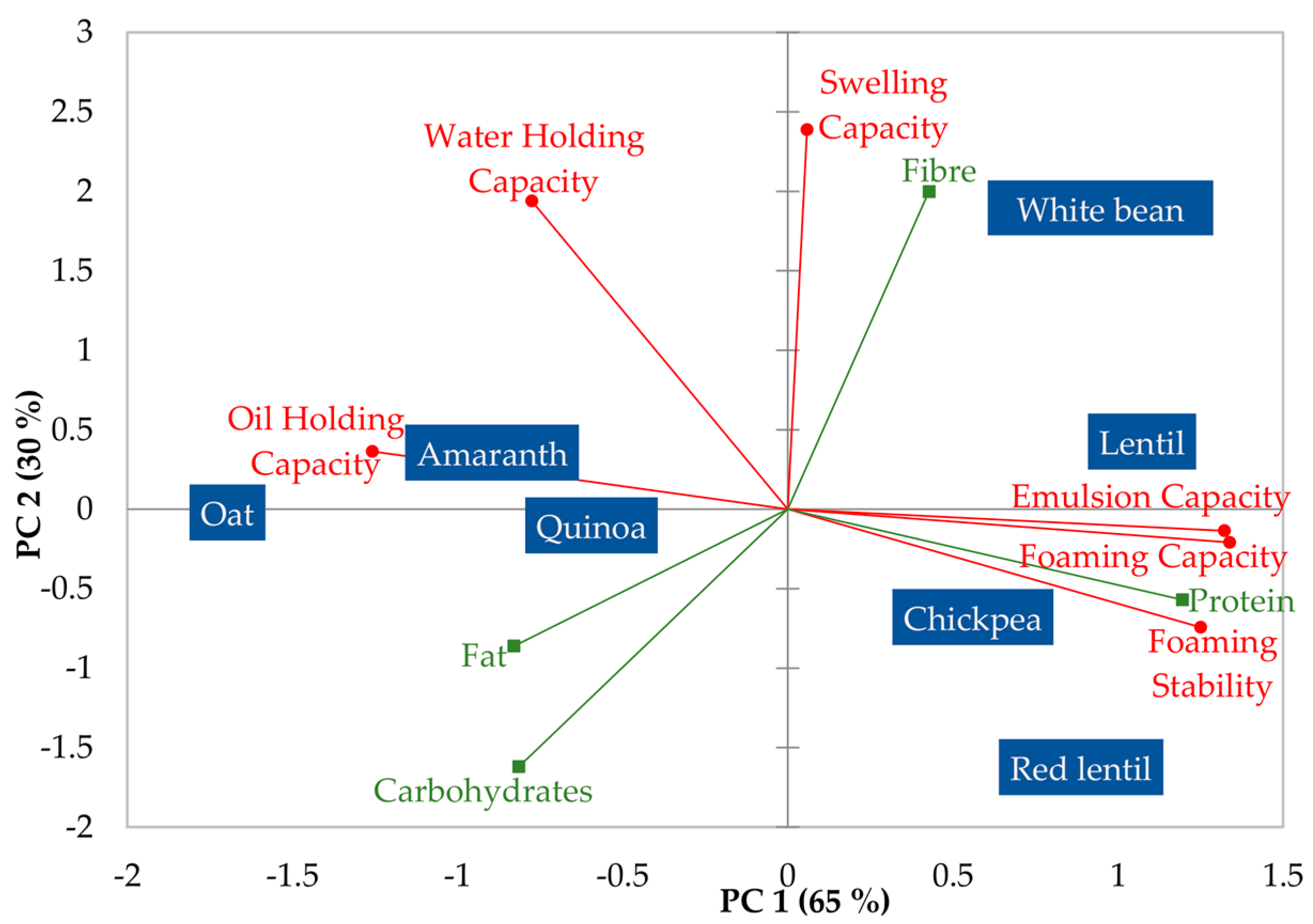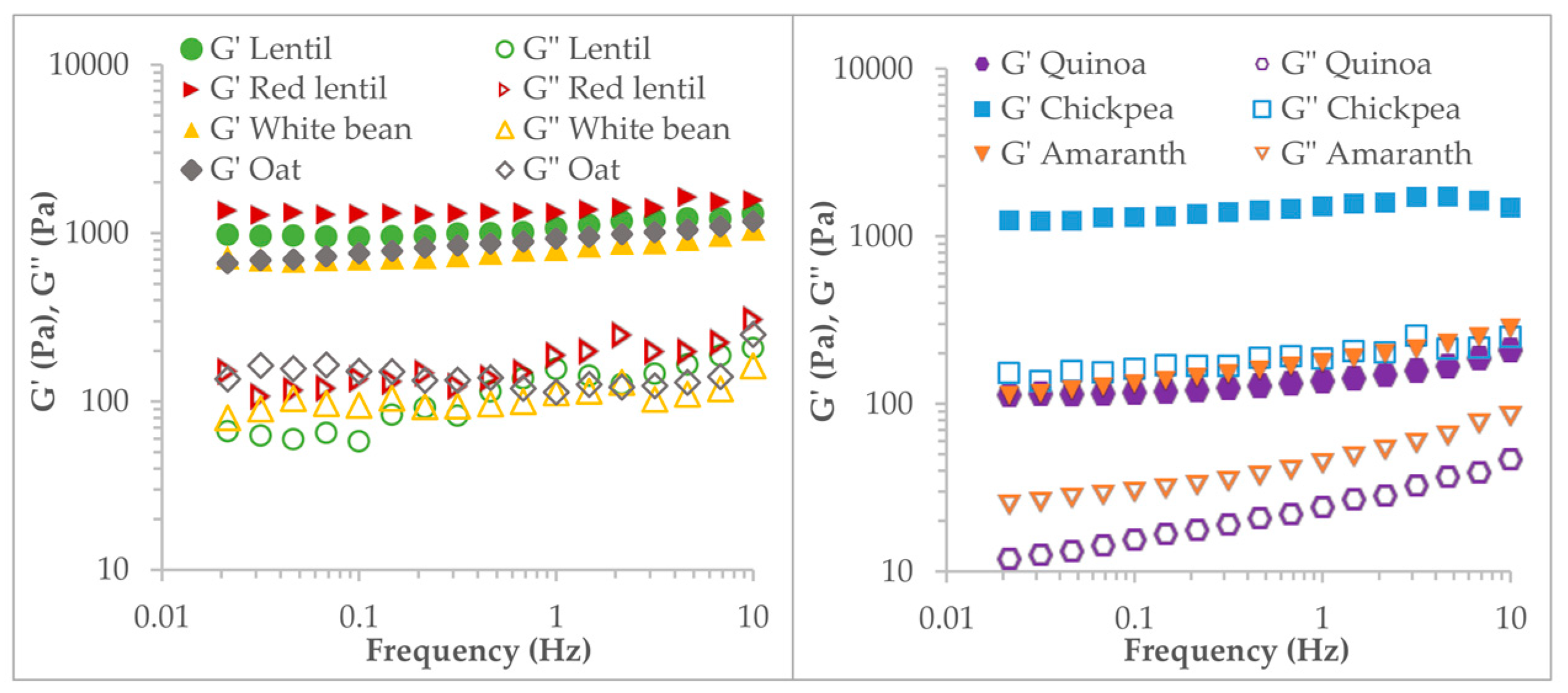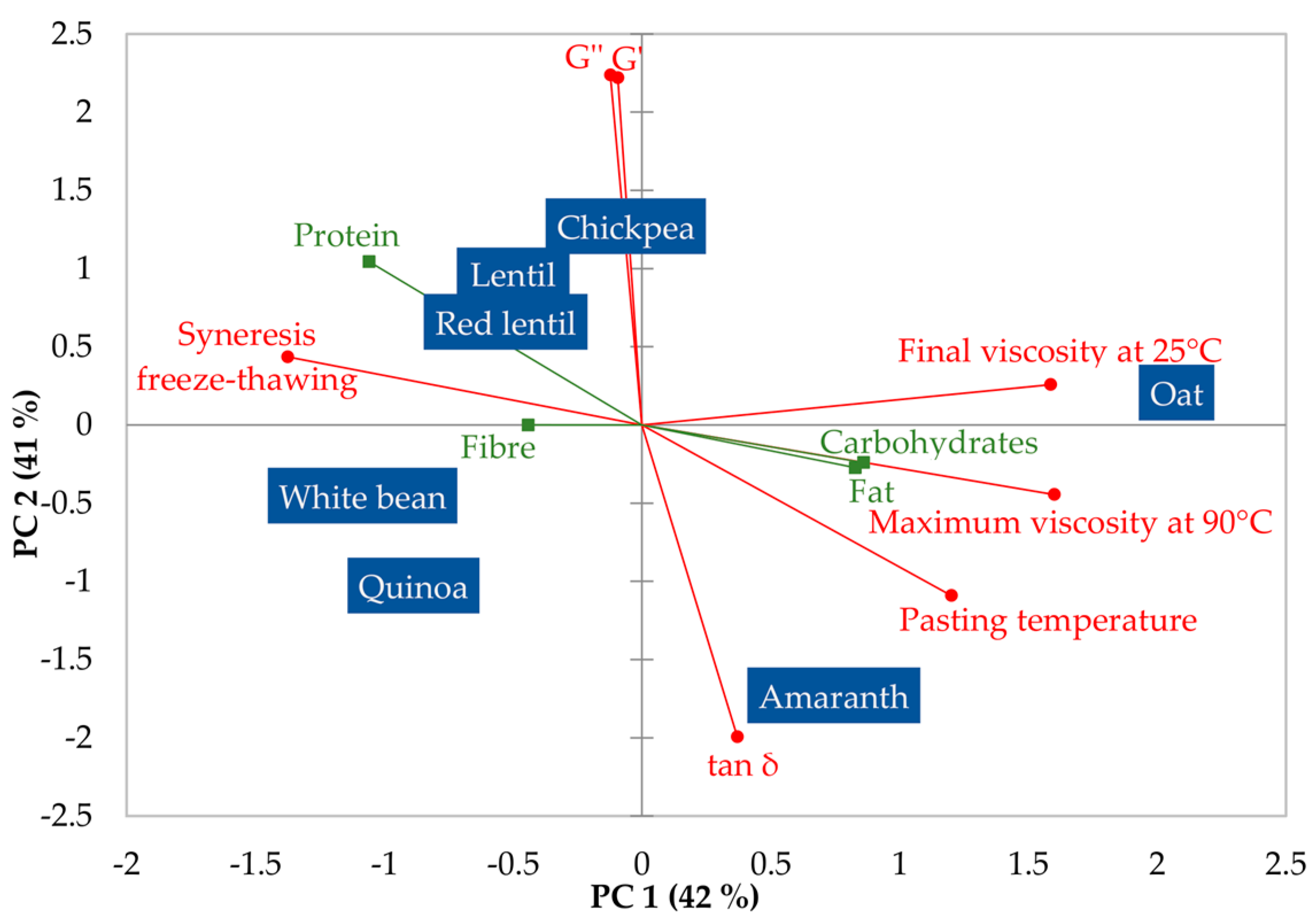Techno-Functional and Rheological Properties of Alternative Plant-Based Flours
Abstract
:1. Introduction
2. Materials and Methods
2.1. Materials
2.2. Proximate Flour’s Composition
2.3. Swelling Capacity of Flours
2.4. Water Holding Capacity and Oil Holding Capacity of Flours
2.5. Emulsifying Capacity of Flours
2.6. Foaming Capacity and Foam Stability of Flours
2.7. Viscosity Profile during the Thermo-Mechanical Process of Flours
2.8. Viscoelastic Properties of Flour Pastes
2.9. Syneresis of Freeze-Thaw Stability of Flour Pastes
2.10. Instrumental Texture Properties of Flour Gels
2.10.1. Compression up to the Rupture Test
2.10.2. Texture Profile Analysis (TPA)
2.11. Data Analysis
3. Results
3.1. Proximate Composition of Flours from Different Vegetable Sources
3.2. Techno-Functional Properties of Flours from Different Vegetable Sources
3.3. Pasting Behaviour of Flours and Rheological Properties of Pastes and Gels
4. Conclusions
Author Contributions
Funding
Data Availability Statement
Acknowledgments
Conflicts of Interest
References
- Magrini, M.-B.; Anton, M.; Chardigny, J.-M.; Duc, G.; Duru, M.; Jeuffroy, M.-H.; Meynard, J.-M.; Micard, V.; Walrand, S. Pulses for Sustainability: Breaking Agriculture and Food Sectors Out of Lock-In. Front. Sustain. Food Syst. 2018, 2, 64. [Google Scholar] [CrossRef] [Green Version]
- Semba, R.D.; Ramsing, R.; Rahman, N.; Kraemer, K.; Bloem, M.W. Legumes as a Sustainable Source of Protein in Human Diets. Glob. Food Secur. 2021, 28, 100520. [Google Scholar] [CrossRef]
- Fischer, E.; Cachon, R.; Cayot, N. Pisum Sativum vs Glycine Max, a Comparative Review of Nutritional, Physicochemical, and Sensory Properties for Food Uses. Trends Food Sci. Technol. 2020, 95, 196–204. [Google Scholar] [CrossRef]
- Peng, Y.; Kersten, N.; Kyriakopoulou, K.; van der Goot, A.J. Functional Properties of Mildly Fractionated Soy Protein as Influenced by the Processing PH. J. Food Eng. 2020, 275, 109875. [Google Scholar] [CrossRef]
- Peng, Y.; Kyriakopoulou, K.; Keppler, J.K.; Venema, P.; van der Goot, A.J. Effect of Calcium Enrichment on the Composition, Conformation, and Functional Properties of Soy Protein. Food Hydrocoll. 2022, 123, 107191. [Google Scholar] [CrossRef]
- Mäkinen, O.E.; Sozer, N.; Ercili-Cura, D.; Poutanen, K. Protein From Oat: Structure, Processes, Functionality, and Nutrition. In Sustainable Protein Sources; Academic Press: Cambridge, MA, USA, 2017; Volume 6, pp. 105–119. [Google Scholar] [CrossRef]
- López, D.N.; Galante, M.; Robson, M.; Boeris, V.; Spelzini, D. Amaranth, Quinoa and Chia Protein Isolates: Physicochemical and Structural Properties. Int. J. Biol. Macromol. 2018, 109, 152–159. [Google Scholar] [CrossRef] [Green Version]
- Kumar, M.; Tomar, M.; Potkule, J.; Verma, R.; Punia, S.; Mahapatra, A.; Belwal, T.; Dahuja, A.; Joshi, S.; Berwal, M.K.; et al. Advances in the Plant Protein Extraction: Mechanism and Recommendations. Food Hydrocoll. 2021, 115, 106595. [Google Scholar] [CrossRef]
- Ferawati, F.; Hefni, M.; Östbring, K.; Witthöft, C. The Application of Pulse Flours in the Development of Plant-Based Cheese Analogues: Proximate Composition, Color, and Texture Properties. Foods 2021, 10, 2208. [Google Scholar] [CrossRef]
- Ladjal Ettoumi, Y.; Chibane, M. Some Physicochemical and Functional Properties of Pea, Chickpea and Lentil Whole Flours. Int. Food Res. J. 2015, 22, 987–996. [Google Scholar]
- Pedrosa, M.M.; Varela, A.; Domínguez-Timón, F.; Tovar, C.A.; Moreno, H.M.; Borderías, A.J.; Díaz, M.T. Comparison of Bioactive Compounds Content and Techno-Functional Properties of Pea and Bean Flours and Their Protein Isolates. Plant Foods Hum. Nutr. 2020, 75, 642–650. [Google Scholar] [CrossRef]
- Shevkani, K.; Singh, N.; Kaur, A.; Rana, J.C. Physicochemical, Pasting, and Functional Properties of Amaranth Seed Flours: Effects of Lipids Removal. J. Food Sci. 2014, 79, C1271–C1277. [Google Scholar] [CrossRef]
- Felix, M.; Camacho-Ocaña, Z.; López-Castejón, M.L.; Ruiz-Domínguez, M. Rheological Properties of Quinoa-Based Gels. An Alternative for Vegan Diets. Food Hydrocoll. 2021, 120, 106827. [Google Scholar] [CrossRef]
- Li, Y.; Obadi, M.; Shi, J.; Xu, B.; Shi, Y.-C. Rheological and Thermal Properties of Oat Flours and Starch Affected by Oat Lipids. J. Cereal Sci. 2021, 102, 103337. [Google Scholar] [CrossRef]
- Official Methods of Analysis, Method 925.09, 991.43, 15th ed.; Association of Official Analytical Chemists: Gaithersburg, MD, USA, 1996.
- Approved Methods of AACC: Method 08-03, 30-10, 9th ed.; The American Association of Cereal Chemists: St Paul, MN, USA, 2000.
- Food Products—Determination of the Total Nitrogen Content by Combustion According to the Dumas Principle and Calculation of the Crude Protein Content—Part 2: Cereals, Pulses and Milled Cereal Products. ISO (International Organization for Standardization)/TS (Technical Specification) 16634-2:2016. Available online: https://www.iso.org/standard/66661.html (accessed on 1 February 2023).
- Robertson, J.A.; de Monredon, F.D.; Dysseler, P.; Guillon, F.; Amado, R.; Thibault, J.-F. Hydration Properties of Dietary Fibre and Resistant Starch: A European Collaborative Study. LWT—Food Sci. Technol. 2000, 33, 72–79. [Google Scholar] [CrossRef]
- Aziah, A.A.N.; Komathi, C.A. Physicochemical and Functional Properties of Peeled and Unpeeled Pumpkin Flour. J. Food Sci. 2009, 74, S328–S333. [Google Scholar] [CrossRef]
- Yasumatsu, K.; Sawada, K.; Moritaka, S.; Misaki, M.; Toda, J.; Wada, T.; Ishii, K. Whipping and Emulsifying Properties of Soybean Productst. Agric. Chem. Soc. 1972, 36, 719–727. [Google Scholar] [CrossRef]
- Bencini, M.C. Functional Properties of Drum-Dried Chickpea (Cicer Arietinum L.) Flours. J. Food Sci. 1986, 51, 1518–1521. [Google Scholar] [CrossRef]
- Wu, Y.; Niu, M.; Xu, H. Pasting Behaviors, Gel Rheological Properties, and Freeze-Thaw Stability of Rice Flour and Starch Modified by Green Tea Polyphenols. LWT 2020, 118, 108796. [Google Scholar] [CrossRef]
- Bayarri, S.; Izquierdo, L.; Durán, L.; Costell, E. Effect of Addition of Sucrose and Aspartame on the Compression Resistance of Hydrocolloids Gels. Int. J. Food Sci. Technol. 2006, 41, 980–986. [Google Scholar] [CrossRef]
- Pons, M.; Fiszman, S.M. Instrumental Texture Profile Analysis with Particular Reference to Gelled Systems. J. Texture Stud. 1996, 27, 597–624. [Google Scholar] [CrossRef]
- Karaca, A.C.; Low, N.; Nickerson, M. Emulsifying Properties of Chickpea, Faba Bean, Lentil and Pea Proteins Produced by Isoelectric Precipitation and Salt Extraction. Food Res. Int. 2011, 44, 2742–2750. [Google Scholar] [CrossRef]
- Damodaran, S. Functional Properties. In Food Proteins: Properties and Characterization; VCH Publisher: New York, NY, USA, 1996; Volume 4, pp. 167–234. [Google Scholar]
- Wang, Z.; Narsimhan, G. Evolution of Liquid Holdup Profile in a Standing Protein Stabilized Foam. J. Colloid Interface Sci. 2004, 280, 224–233. [Google Scholar] [CrossRef] [PubMed]
- Davis, J.P.; Foegeding, E.A. Comparisons of the Foaming and Interfacial Properties of Whey Protein Isolate and Egg White Proteins. Colloids Surf. B Biointerfaces 2007, 54, 200–210. [Google Scholar] [CrossRef] [PubMed]
- Spaen, J.; Silva, J.V.C. Oat Proteins: Review of Extraction Methods and Techno-Functionality for Liquid and Semi-Solid Applications. LWT 2021, 147, 111478. [Google Scholar] [CrossRef]
- Bolontrade, A.J.; Scilingo, A.A.; Añón, M.C. Amaranth Proteins Foaming Properties: Adsorption Kinetics and Foam Formation—Part 1. Colloids Surf. B Biointerfaces 2013, 105, 319–327. [Google Scholar] [CrossRef] [PubMed]
- Ventureira, J.L.; Martínez, E.N.; Añón, M.C. Effect of Acid Treatment on Structural and Foaming Properties of Soy Amaranth Protein Mixtures. Food Hydrocoll. 2012, 29, 272–279. [Google Scholar] [CrossRef]
- Dakhili, S.; Abdolalizadeh, L.; Hosseini, S.M.; Shojaee-Aliabadi, S.; Mirmoghtadaie, L. Quinoa Protein: Composition, Structure and Functional Properties. Food Chem. 2019, 299, 125161. [Google Scholar] [CrossRef]
- Berggren, S.; Ellen Hedrén; Edman, K.; Karlsson, B. Water Holding Capacity and Viscosity of Ingredients from Oats—The Effect of β-Glucan and Starch Content, Particle Size, PH and Temperature. Bachelor’s Thesis, Linnaeus University, Växjö, Sweden, 2017. [Google Scholar]
- Niu, M.; Hou, G.G.; Zhao, S. Dough Rheological Properties and Noodle-Making Performance of Non-Waxy and Waxy Whole-Wheat Flour Blends. J. Cereal Sci. 2017, 75, 261–268. [Google Scholar] [CrossRef]
- Sandhu, K.; Singh, N. Some Properties of Corn Starches II: Physicochemical, Gelatinization, Retrogradation, Pasting and Gel Textural Properties. Food Chem. 2007, 101, 1499–1507. [Google Scholar] [CrossRef]
- Wang, Y.; Gong, X.; Zhang, Y.; Geng, D.; Cao, L.; Ruan, C.; Yu, L.; Zhang, D.; Tong, L. Effect of Peeling Treatment on the Physicochemical Properties of Quinoa Flour. J. Food Process Eng. 2020, 43, e13387. [Google Scholar] [CrossRef]
- Kumar, L.; Brennan, M.; Zheng, H.; Brennan, C. The Effects of Dairy Ingredients on the Pasting, Textural, Rheological, Freeze-Thaw Properties and Swelling Behaviour of Oat Starch. Food Chem. 2018, 245, 518–524. [Google Scholar] [CrossRef]
- Srichuwong, S.; Sunarti, T.C.; Mishima, T.; Isono, N.; Hisamatsu, M. Starches from Different Botanical Sources II: Contribution of Starch Structure to Swelling and Pasting Properties. Carbohydr. Polym. 2005, 62, 25–34. [Google Scholar] [CrossRef]
- Duque, S.M.M.; Leong, S.Y.; Agyei, D.; Singh, J.; Larsen, N.; Oey, I. Understanding the Impact of Pulsed Electric Fields Treatment on the Thermal and Pasting Properties of Raw and Thermally Processed Oat Flours. Food Res. Int. 2020, 129, 108839. [Google Scholar] [CrossRef]
- Wang, L.; Zhang, L.; Wang, H.; Ai, L.; Xiong, W. Insight into Protein-Starch Ratio on the Gelatinization and Retrogradation Characteristics of Reconstituted Rice Flour. Int. J. Biol. Macromol. 2020, 146, 524–529. [Google Scholar] [CrossRef]
- Jiang, Z.-Q.; Wang, J.; Stoddard, F.; Salovaara, H.; Sontag-Strohm, T. Preparation and Characterization of Emulsion Gels from Whole Faba Bean Flour. Foods 2020, 9, 755. [Google Scholar] [CrossRef]
- Schmitt, C.; Silva, J.V.; Amagliani, L.; Chassenieux, C.; Nicolai, T. Heat-Induced and Acid-Induced Gelation of Dairy/Plant Protein Dispersions and Emulsions. Curr. Opin. Food Sci. 2019, 27, 43–48. [Google Scholar] [CrossRef]
- Shevkani, K.; Singh, N.; Chen, Y.; Kaur, A.; Yu, L. Pulse Proteins: Secondary Structure, Functionality and Applications. J. Food Sci. Technol. 2019, 56, 2787–2798. [Google Scholar] [CrossRef]





| Flour Granulation (%) for Each Mesh Size | Chickpea | Lentil | Red Lentil | White Bean | Quinoa | Amaranth | Oat |
|---|---|---|---|---|---|---|---|
| >354 µ | 25.2 | 7.5 | 0.5 | 3.5 | 0.0 | 49.8 | 67.5 |
| 125–354 µ | 56.1 | 51.0 | 46.6 | 73.1 | 84.3 | 44.0 | 31.2 |
| 90–125 µ | 9.7 | 17.5 | 17.3 | 8.3 | 8.1 | 4.0 | 0.8 |
| <90 µ | 9.0 | 24.0 | 35.6 | 15.1 | 7.6 | 2.2 | 0.5 |
| Moisture content (%) | 8.8 | 7.9 | 8.8 | 10.2 | 10.6 | 11.3 | 10.6 |
| Flours | Protein (%) | Fat (%) | Fibre (%) | Carbohydrates (%) |
|---|---|---|---|---|
| White bean | 19.2 bc (2.9) | 2.1 d (0.2) | 33.5 a (0.5) | 31.3 d (3.4) |
| Chickpea | 16.9 c (2.0) | 6.3 a (0.4) | 14.0 c (1.1) | 51.1 bc (1.0) |
| Lentil | 24.0 ab (2.8) | 1.4 e (0.3) | 16.4 b (0.9) | 48.1 c (3.4) |
| Red lentil | 25.9 a (1.2) | 2.9 c (0.1) | 9.8 e (0.6) | 50.4 bc (1.2) |
| Quinoa | 16.2 cd (2.0) | 4.6 b (0.5) | 8.7 e (0.4) | 57.4 a (0.6) |
| Amaranth | 14.9 cd (0.6) | 4.9 b (0.1) | 11.8 d (1.1) | 54.7 ab (1.4) |
| Oat | 11.6 d (2.4) | 5.1 b (0.1) | 15.3 bc (0.5) | 55.6 ab (2.4) |
| Flours | Swelling Capacity (mL/g) | Water Holding Capacity (g/g) | Oil Holding Capacity (g/g) | Emulsifying Capacity (%) | Foaming Capacity (%) | Foaming Stability (%) |
|---|---|---|---|---|---|---|
| Chickpea | 2.90 bc (0.64) | 1.00 d (0.01) | 0.77 bc (0.01) | 51.4 a (0.7) | 46.2 b (5.7) | 32.6 ab (5.4) |
| Lentil | 3.23 b (0.21) | 1.31 c (0.07) | 0.69 c (0.04) | 46.2 c (3.3) | 57.1 a (3.1) | 43.2 a (10.6) |
| Red lentil | 2.49 c (0.10) | 0.72 e (0.01) | 0.69 c (0.01) | 49.7 ab (3.3) | 57.9 a (5.1) | 42.5 a (3.9) |
| White bean | 3.99 a (0.26) | 1.64 a (0.03) | 0.78 bc (0.03) | 47.7 bc (2.1) | 48.7 ab (9.0) | 23.0 b (9.0) |
| Quinoa | 3.09 b (0.07) | 1.43 bc (0.17) | 0.93 a (0.11) | 13.8 d (1.2) | 34.3 c (10.0) | 24.1 b (3.6) |
| Amaranth | 3.23 b (0.33) | 1.58 ab (0.06) | 0.85 ab (0.10) | 3.3 e (0.4) | 13.6 d (4.8) | 4.9 c (2.8) |
| Oat | 3.05 b (0.11) | 1.60 a (0.13) | 0.97 a (0.09) | 0.5 e (0.4) | 0.0 e (0.0) | 0.0 c (0.0) |
| Flours | Pasting Temperature (°C) | Max. Viscosity at 90 °C (Pa·s) | Final Viscosity at 25 °C (Pa·s) |
|---|---|---|---|
| Chickpea | 73.3 d (0.3) | 0.59 c (0.02) | 1.01 c (0.03) |
| Lentil | 73.2 d (0.2) | 0.36 e (0.01) | 0.99 c (0.02) |
| Red lentil | 75.6 c (0.1) | 0.34 e (0.02) | 0.76 d (0.04) |
| White bean | 78.9 b (1.4) | 0.21 f (0.01) | 0.59 f (0.01) |
| Quinoa | 72.8 d (0.2) | 0.55 d (0.01) | 0.66 e (0.02) |
| Amaranth | 82.7 a (0.0) | 0.84 b (0.01) | 1.23 b (0.01) |
| Oat | 82.9 a (0.1) | 1.21 a (0.02) | 3.58 a (0.07) |
| Flours | G′ (Pa) | G″ (Pa) | tan δ (G″/G′) |
|---|---|---|---|
| Chickpea | 1609 a (101) | 206 a (24) | 0.13 c (0.01) |
| Lentil | 1386 a (82) | 187 ab (12) | 0.14 bc (0.01) |
| Red lentil | 1432 a (42) | 168 b (17) | 0.12 c (0.03) |
| White bean | 625 b (40) | 98 c (12) | 0.16 bc (0.02) |
| Quinoa | 122 c (27) | 21 d (5) | 0.17 b (0.01) |
| Amaranth | 92 c (6) | 29 d (6) | 0.32 a (0.05) |
| Oat | 775 b (24) | 108 c (10) | 0.14 bc (0.01) |
| Flours | Young’s Modulus × 10−2 (N/mm2) | Hardness (N) | Springiness |
|---|---|---|---|
| Chickpea | 2.51 a (0.3) | 0.66 a (0.02) | 0.83 a (0.01) |
| Lentil | 2.30 b (0.3) | 0.64 a (0.03) | 0.81 a (0.01) |
| Red lentil | 1.27 c (0.3) | 0.38 b (0.05) | 0.66 b (0.02) |
Disclaimer/Publisher’s Note: The statements, opinions and data contained in all publications are solely those of the individual author(s) and contributor(s) and not of MDPI and/or the editor(s). MDPI and/or the editor(s) disclaim responsibility for any injury to people or property resulting from any ideas, methods, instructions or products referred to in the content. |
© 2023 by the authors. Licensee MDPI, Basel, Switzerland. This article is an open access article distributed under the terms and conditions of the Creative Commons Attribution (CC BY) license (https://creativecommons.org/licenses/by/4.0/).
Share and Cite
Badia-Olmos, C.; Laguna, L.; Haros, C.M.; Tárrega, A. Techno-Functional and Rheological Properties of Alternative Plant-Based Flours. Foods 2023, 12, 1411. https://doi.org/10.3390/foods12071411
Badia-Olmos C, Laguna L, Haros CM, Tárrega A. Techno-Functional and Rheological Properties of Alternative Plant-Based Flours. Foods. 2023; 12(7):1411. https://doi.org/10.3390/foods12071411
Chicago/Turabian StyleBadia-Olmos, Celia, Laura Laguna, Claudia Mónika Haros, and Amparo Tárrega. 2023. "Techno-Functional and Rheological Properties of Alternative Plant-Based Flours" Foods 12, no. 7: 1411. https://doi.org/10.3390/foods12071411





